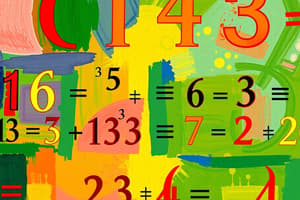Podcast
Questions and Answers
The formula for the 𝑛 𝑡ℎ term of an arithmetic sequence is 𝑎ₙ = 𝑎₁ + (𝑛 - 1)𝑑.
The formula for the 𝑛 𝑡ℎ term of an arithmetic sequence is 𝑎ₙ = 𝑎₁ + (𝑛 - 1)𝑑.
True (A)
The term 'arithmetic mean' refers to the middle value of a set of data.
The term 'arithmetic mean' refers to the middle value of a set of data.
False (B)
The 𝑛 𝑡ℎ term of an arithmetic sequence can be found using the formula 𝑎ₙ = 𝑎₁ + (𝑛 - 1)𝑑.
The 𝑛 𝑡ℎ term of an arithmetic sequence can be found using the formula 𝑎ₙ = 𝑎₁ + (𝑛 - 1)𝑑.
True (A)
Arithmetic means are used to find the median of a set of data.
Arithmetic means are used to find the median of a set of data.
Arithmetic sequences have a constant difference between consecutive terms.
Arithmetic sequences have a constant difference between consecutive terms.
The first term of an arithmetic sequence is always 0.
The first term of an arithmetic sequence is always 0.
Arithmetic means are used to find the average of a set of data.
Arithmetic means are used to find the average of a set of data.
The formula for the nth term of an arithmetic sequence is an = an-1 + d.
The formula for the nth term of an arithmetic sequence is an = an-1 + d.
The nth term of an arithmetic sequence is always an integer.
The nth term of an arithmetic sequence is always an integer.
The nth term of an arithmetic sequence can be found using the formula an = a1 + nd.
The nth term of an arithmetic sequence can be found using the formula an = a1 + nd.
The $n$th term of an arithmetic sequence can be found using the formula $aₙ = a₁ + (n - 1)d$.
The $n$th term of an arithmetic sequence can be found using the formula $aₙ = a₁ + (n - 1)d$.
An arithmetic sequence can have a fractional common difference.
An arithmetic sequence can have a fractional common difference.
The arithmetic mean of a set of data is always the same as the median.
The arithmetic mean of a set of data is always the same as the median.
An arithmetic sequence can be used to model a real-world problem involving a linear pattern.
An arithmetic sequence can be used to model a real-world problem involving a linear pattern.
The $n$th term of an arithmetic sequence is always the same as the first term.
The $n$th term of an arithmetic sequence is always the same as the first term.
Flashcards are hidden until you start studying
Study Notes
Arithmetic Sequences Overview
- An arithmetic sequence is a sequence of numbers where the difference between consecutive terms is constant, known as the common difference (d).
- The formula for the 𝑛𝑡ℎ term of an arithmetic sequence can be expressed as:
- aₙ = a₁ + (n - 1) * d*
where a₁ is the first term and n is the term position.
Finding the 𝑛𝑡ℎ Term
- To find the 𝑛𝑡ℎ term, plug the values of the first term (a₁), common difference (d), and n into the formula.
- Example: For a sequence 2, 5, 8, 11, where a₁ = 2 and d = 3, the 5th term is calculated as:
- a₅ = 2 + (5 - 1) * 3 = 14.*
Definition of Arithmetic Means
- An arithmetic mean is the average of two or more numbers in an arithmetic sequence and can help to find missing terms.
- It can also be defined as the middle term in three consecutive terms of an arithmetic sequence.
Determining Arithmetic Means
- To determine arithmetic means between two numbers, find the common difference that would fit evenly between them.
- For example, to find the mean between 4 and 10:
- Common difference (d) = (10 - 4) / 2 = 3
- Means: 4, 7, 10.
Solving Problems Involving the 𝑛𝑡ℎ Term
- Problems may require finding an unknown term, determining the common difference, or calculating the total number of terms.
- Ensure to set up equations based on the given terms and use the formula appropriately.
- Example problem: If a₁ = 10 and a₇ = 34, find the common difference.
- Set up: 34 = 10 + (7 - 1)d, solve for d = 4.
Studying That Suits You
Use AI to generate personalized quizzes and flashcards to suit your learning preferences.




